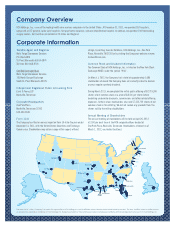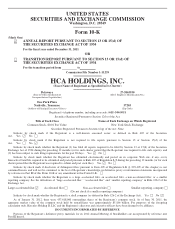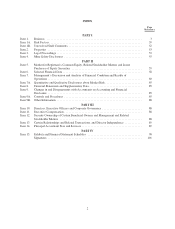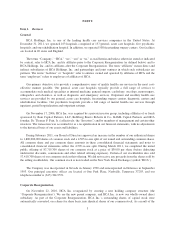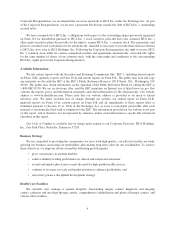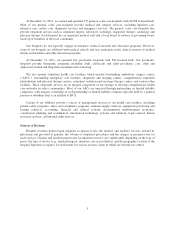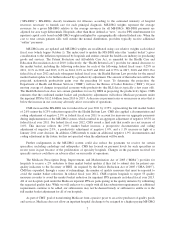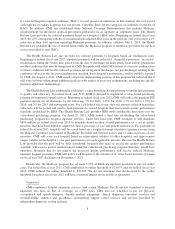HCA Holdings 2011 Annual Report Download - page 12
Download and view the complete annual report
Please find page 12 of the 2011 HCA Holdings annual report below. You can navigate through the pages in the report by either clicking on the pages listed below, or by using the keyword search tool below to find specific information within the annual report.
Hospital outpatient services paid under PPS are classified into groups called ambulatory payment
classifications (“APCs”). Services for each APC are similar clinically and in terms of the resources they require.
A payment rate is established for each APC. Depending on the services provided, a hospital may be paid for
more than one APC for a patient visit. The APC payment rates are updated for each calendar year. For calendar
year 2011, CMS increased APC payment rates by 2.35%, which represented a market basket update of 2.6% and
a 0.25% reduction required by the Health Reform Law. The Health Reform Law also provides for the following
reductions to the market basket update for each of the following calendar years: 0.1% in 2012 and 2013, 0.3% in
2014, 0.2% in 2015 and 2016 and 0.75% in 2017, 2018 and 2019. For calendar year 2012 and each subsequent
calendar year, the Health Reform Law provides for an annual market basket update to be further reduced by a
productivity adjustment. The amount of that reduction will be the projected, nationwide productivity gains over
the preceding 10 years. To determine the projection, HHS will use the BLS 10-year moving average of changes
in specified economy-wide productivity (the BLS data is typically a few years old). The Health Reform Law does
not contain guidelines for use by HHS in projecting the productivity figure. However, CMS estimates that the
combined market basket and productivity adjustments will reduce Medicare payments under the outpatient PPS
by $26.3 billion from 2010 to 2019. CMS has issued a final rule that increases the APC payment rate for calendar
year 2012 by 1.9%, which includes the full market basket update of 3.0%, a negative 1.0% productivity
adjustment and the negative 0.1% adjustment required by the Health Reform Law. CMS continues to require
hospitals to submit quality data relating to outpatient care to avoid receiving a 2% reduction to the market basket
update under the outpatient PPS. CMS required hospitals to report data on 15 quality measures in calendar year
2011 for the payment determination in calendar year 2012 and requires hospitals to report 23 quality measures in
calendar year 2012 to avoid reduced payments in calendar year 2013.
Rehabilitation
CMS reimburses inpatient rehabilitation facilities (“IRFs”) on a PPS basis. Under the IRF PPS, patients are
classified into case mix groups based upon impairment, age, comorbidities (additional diseases or disorders from
which the patient suffers) and functional capability. IRFs are paid a predetermined amount per discharge that
reflects the patient’s case mix group and is adjusted for area wage levels, low-income patients, rural areas and high-
cost outliers. For federal fiscal year 2011, CMS updated the market basket by 2.25%, which represented the full
market basket of 2.5% reduced by 0.25% as required by the Health Reform Law. The Health Reform Law also
provides for the following reductions to the market basket update for each of the following federal fiscal years:
0.1% in 2012 and 2013, 0.3% in 2014, 0.2% in 2015 and 2016 and 0.75% in 2017, 2018 and 2019. For federal fiscal
year 2012 and each subsequent federal fiscal year, the Health Reform Law provides for the annual market basket
update to be further reduced by a productivity adjustment. The amount of that reduction will be the projected,
nationwide productivity gains over the preceding 10 years. To determine the projection, HHS will use the BLS 10-
year moving average of changes in specified economy-wide productivity (the BLS data is typically a few years old).
The Health Reform Law does not contain guidelines for use by HHS in projecting the productivity figure. However,
CMS estimates that the combined market basket and productivity adjustments will reduce Medicare payments under
the IRF PPS by $5.7 billion from 2010 to 2019. For federal fiscal year 2012, CMS has issued a final rule updating
inpatient rehabilitation payment rates by 2.2%, which reflects a 2.9% market basket increase, a negative 1.0%
productivity adjustment, a 0.1% reduction required by the Health Reform Law, and a 0.4% increase resulting from
an update to the outlier threshold amount. Beginning in federal fiscal year 2014, IRFs will be required to report
quality measures to CMS or will receive a two percentage point reduction to the market basket update.
In order to qualify for classification as an IRF, at least 60% of a facility’s inpatients during the most recent
12-month CMS-defined review period must have required intensive rehabilitation services for one or more of
13 specified conditions. IRFs must also meet additional coverage criteria, including patient selection and care
requirements relating to pre-admission screenings, post-admission evaluations, ongoing coordination of care and
involvement of rehabilitation physicians. A facility that fails to meet the 60% threshold or other criteria to be
classified as an IRF will be paid under the acute care hospital inpatient or outpatient PPS, which generally
provide for lower payment amounts. As of December 31, 2011, we had one rehabilitation hospital and 42
hospital rehabilitation units.
9


